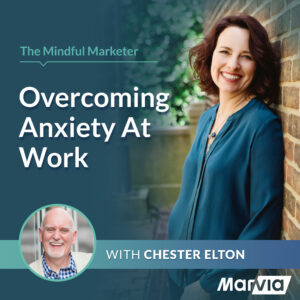When it comes to our careers and our customer relationships, the way we FEEL frames our reality.
Yet there is a “reality paradox” happening in our workplaces.
On the one hand, we are witnessing declining unemployment (now 4.8% in the USA), soaring corporate and consumer spending, and a frenetic hiring pace for marketing and CX professionals. 50% of my clients have either been promoted or changed careers in the past 22 months.
On the other hand, drug overdoses in the USA have surpassed 100,000 this year. Mental health professionals are maxed out. Daycare and labor shortages impose stress for many families, and service workers are simply on edge.
Anxiety is casting a shadow over today’s economic news.
Our job as marketing leaders is to keep our team’s lights on, as well as our own. That means we need ideas and strategies to minimize the long term harmful effects of anxiety, which is when we worry about the future, about things that have not happened.

Chester Elton, a fellow 100 Coaches colleague and co-author of Anxiety at Work, joined me in this special episode. He states plainly that it’s time we remove the stigma and name it.
Named one of the top Global Gurus of Leadership and the Apostle of Appreciation, his four bestselling books have sold over 1.6 million copies.
Chester works with top leaders at American Express, AT&T, Avis Budget Group, the NHL, and Procter & Gamble.
Together we outlined the sources of anxiety at work and ways you can mitigate them.
Tune in this 49th episode of The Mindful Marketer show —
Key points covered in this episode:
✔️ You can’t have a healthy team and a productive culture if you’re not addressing mental health and safety. When someone in a position of leadership has themselves been anxious, it requires transparency & sharing from their heart what they have been experiencing. This helps others recognize that what they are feeling isn’t pathologic, but is quite normal in this climate.
✔️ Understand the distinction between anxiety and depression. Anxiety happens when you spend too much time worrying or obsessing about things that have not happened and may never happen in the future, while depression is when you overthink or obsess about something that happened in the past.
✔️ 90% of employees won’t talk to their boss about mental health or anxiety. It’s time to normalize the conversation around mental health in the workplace. Chester invites us to look at it in this context. “If you broke your arm and came to work with your arm in a sling, they say, ‘Lisa, take some time off. Have you seen all the right doctors? Have you taken care of everything you need to take care of?’ And yet, when somebody comes to work with anxiety or other mental health issues, we won’t talk about that. We’ll talk about a broken arm, but we won’t talk about anxiety.”
✔️ Anxiety appears in different forms. We either psychologize or somaticize our anxiety. Dr. Anna Yusim, a clinical faculty at Yale who has been managing stress in the workplace for the last 15 years, explains how often these manifests in different ways in different people. She also provided her perspectives and guidance during this livestream.
Listen to the replay on Stitcher for Anna’s and Chester’s insights.
✔️ Provide ample resources to help people deal with their anxiety. Lending them an ear is essential. Refer they to your Employee Assistance Program (a grossly underutilized resource in the USA). Suggest a therapist so that the anxiety does not become a diagnosable condition that further affects their workplace performance and social structures.
✔️ Be careful how you delegate! Watch out for giving loads of extra work to your most effective people. Often, your top performers have the most anxiety. They’re the ones that don’t ever want to let anybody down and are defined by the quality of their work and how many boxes they can check by day’s end. Chester advises looking for changes in behaviour. These top performers never say no, and they’re good at hiding it.
This time of year often brings holiday travel hassles, over-shopping, and dreaded family dynamics. Some will feel energizing; others anxiety-producing. Please keep this in mind as you lead your teams towards a new year.
Most importantly, find the support you need to keep your own lights shining brightly.
I have my chosen family, my coaches, and my partner on speed dial for a reason.
